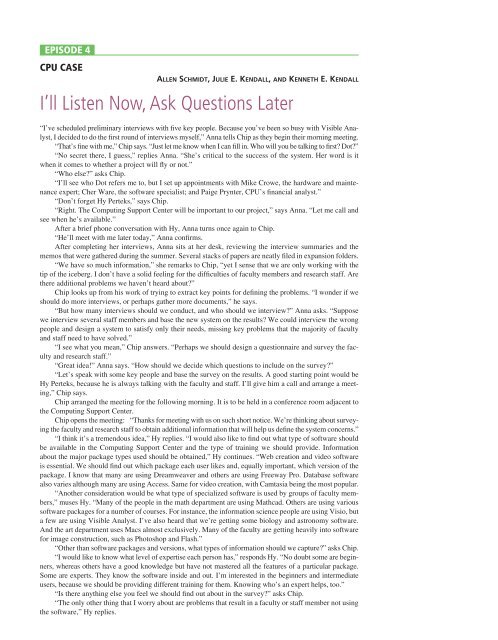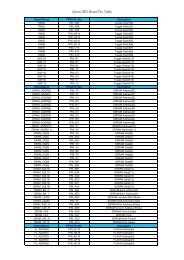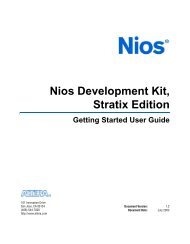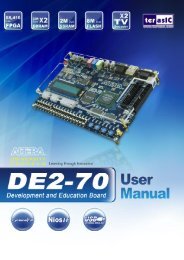I'll Listen Now, Ask Questions Later - Faculty.lasierra.edu
I'll Listen Now, Ask Questions Later - Faculty.lasierra.edu
I'll Listen Now, Ask Questions Later - Faculty.lasierra.edu
You also want an ePaper? Increase the reach of your titles
YUMPU automatically turns print PDFs into web optimized ePapers that Google loves.
a hold on my phone calls. I didn’t know at the time we’d be working together. But (she continues with alaugh), it seems sooner or later, computer people find each other. I’ve heard through the grapevine thatyour group is contemplating helping us out of our quagmire here.Anna: I’m not sure it’s a “quagmire,” but the administration has requested that the Systems and Programminggroup help you manage your computers with a system of your own.Dot: (Sitting back in her chair with a chuckle) I couldn’t be more delighted. That means that my efforts toget some help—or should I say my unabashed pleading—has not fallen on deaf ears. Tell me more.Anna: I thought I’d keep this first interview short, about a half an hour to 45 minutes (glancing at herwatch). My overall objective is to find out about usage of computers on campus currently, from yourperspective. <strong>Later</strong> we can get into the system you use to manage the computers and its strengths andweaknesses.Dot: It’s easy enough to give an overview because it’s something I often communicate to people. Let mebegin with a little history so you can understand where I’m coming from. We started getting involved withPCs way back in the early 1980s. We thought we were very high-tech to be buying them as fast as theywere produced. This exploded in the 1990s and continues to grow today.Anna: Yes. Not many schools or even businesses had a plan for implementing personal computer systems.Dot: Don’t be misled by the haze of history. We purchased some PCs early, mostly for the accountingarea. But we didn’t have a plan, except that we reacted to demand. The beginning was slow, but oncehardware and software became available, we grew explosively. When a marketing professor saw what accountingwas doing, he or she would say, “What’s new for me? We don’t want to deal with the mainframeunless we have to.” And so we grew and grew. We now have about 2,850 networked computers, includinglaptops. Each is typically networked to a printer or several printers. Some are connected to a scanner. Doyou believe there are more than 6,000 tagged items in our inventory? By the end of next fall, 200 morecomputers will be added. You have probably noticed that we have a mix of brands. Windows machinesare used primarily in the Business courses, and Macs are used in the art and Visual Communicationsdepartment. Science areas like to use both Windows machines and Macs, it seems. By the way, we usethe term computer to represent any desktop or notebook computer. Both are kept in inventory. We use theterm hardware to include not only computers but scanners, digital cameras, printers, projectors, and otherdigital equipment.Anna: (Nodding as she absorbs Dot’s response) That’s a lot for anyone to manage. But you seem to beup-to-date on what you have in inventory. What system are you using now to keep track of it all?Dot: I’ve been here since the beginning, and I honestly believe we’ve done better than most, but still thedatabase system we use is inadequate. Again, my analysis is that just like we outgrew old machines, wehave outgrown our management system. But we are reluctant to fiddle with it too much.Anna: Why?Dot: Well, I guess it’s because something is better than nothing, even if that something is antiquated. Wetry to be resourceful. It all started in the late 1980s. Along with the few other people who were assignedto computer support (on a part-time basis, back then), I began to realize that something had to be done toprevent chaos. People were asking us for things, and we couldn’t lay our hands on them. At the same time,computers were breaking down, and we did not know who had the service contract on them, if they hadever been serviced, and so on. We sensed disaster in the making. From our old mainframe experience, westarted trying to organize what we had in a logical way. We all agreed to get a system running with a littleoff-the-shelf database package (which was not user friendly, I’d like to point out). We had very much afamily atmosphere at the time.Anna: What functions did the package perform?Dot: It was very basic information, which is what we desperately needed at the time. It sounds simplenow, but we took some time, and we were thrilled to have inventory information, including the type ofequipment, the manufacturer, initial cost, room number where equipment was located, serial number, andequipment purchase date. Even that took extensive updating.Anna: Is it the same system you run today?Dot: Yes and no. Same software, but we’ve been through three updates.Anna: What other improvements were made?Dot: After using the system for a couple of years, we knew what we wanted. We added fields to capturethe memory size on each computer and other features of the hardware.Anna: And is this the same system you are using now?Dot: Yes, yes it is. We can print a number of reports and some summary information. But don’t get thewrong impression: The system as it stands is clearly inadequate. You won’t get much argument on thatpoint from anyone you interview. But we did what we could with what we had at the time. In fact, there
are still a few members of the original group here. I will admit that it’s been interesting to watch the computersgrow. It makes me feel like I had a hand in helping develop a very important area.Anna: What do you see as the strengths of the current system?Dot: I was in it from the start, so I find it fairly easy to use. And it’s flexible enough to produce a varietyof reports. It’s brought us quite far, and it does provide the elementary information required to manage thecomputers.Anna: Earlier you alluded to some limitations of the system. What are the specific weaknesses you werespeaking about?Dot: (Reflecting before she speaks) In a way, they are not weaknesses of the system per se, but they arechanges in the types of computers we are seeing that the system was not far-sighted enough to accommodate—forinstance, the types of optical drives that are available. The laptops have their own optical drivesthat we don’t replace, but the desktops and newer laptops are including Blu-ray drives, but don’t ask meanything about the technical differences! Many have single hard drives, but some have dual hard drives.Some of the computers are connected to two monitors.Anna: How do you track what software is installed on which machine?Dot: Well, unfortunately, we don’t have a good grasp of that. We started to track it, but as I mentioned,the whole computer area exploded campuswide. We spend so much time putting out brush fires that we’relosing the battle to keep track of the information we have.Anna: Are there similar problems with maintaining the equipment?Dot: You’re getting the idea now. We fix whatever we can as soon as possible. Some of the machines areshipped out on warranty. We don’t even dream of preventive maintenance on desktops, even though weagree that it is important.Anna: Really, I am interested in what you are dreaming about for the new system. What would you like itto accomplish?Dot: That’s easy for me to summarize. All the weaknesses I’ve outlined should be addressed. I’d like itto have a dossier about each machine and when it was purchased. We have a refresh program that replacescomputers after a certain interval, which depends on the machine. Laptops are refreshed at a shorter duration.I would also like to have good cost and repair information maintained. As changes occur, we need tokeep the database up to date.Anna: Anything specifically related to software?Dot: Software cross-referencing is a must.Anna: One of the items I picked up on during our conversation today has been your dissatisfaction withthe capability of the old system to keep pace with the growth in computers. How would any future plansaffect the system we develop?Dot: Certainly we will be adding and refreshing a significant number of machines every year. Therequests for machines far exceed the budget for several years. We expect that new technology will requirepurchasing machines with much more computing capability. The system must be able to keep track of allthis information. Also, the use of individuals using notebooks is growing steadily.Anna: (Glancing at her notes) We’ve covered quite a bit. I think I am beginning to understand what theold system does and doesn’t do, what you’d like to see in the new system, and what you project for growthin the coming years. Is there anything else that you think is important for me to know that I haven’t asked?Dot: It’s an oversight of mine, but I should mention that we also have computers on our four satellitecampuses in outlying areas. Those machines and all they entail need to be included in our system plans.Anna: I know there are several people who can help with this project. Is there anyone in particular youwould recommend that I talk to?Dot: There are several people you will want to seek out. They will be very useful to us. Mike Crowe isour technical support and maintenance expert. He’s been here almost as long as I have. You will enjoy himvery much. His counterpart in software is Cher Ware. She’s easy to talk with. Don’t forget to touch basewith Paige Prynter. She’s in charge of financial information about the PCs. She’ll have what you need inthat area. And Hy Perteks runs the Computing Support Center for us. Certainly you will want to see himbefore you’re done.Anna: Yes. In fact, they are already on my sch<strong>edu</strong>le. We must be thinking alike. As I summarize ourinterview for the systems team, I may have some follow-up questions for you.Dot: I’m delighted to be a part of this. Call me anytime.Anna: (Standing up and extending her hand to Dot) Thanks very much for your time. The informationyou’ve provided has given me a solid start. I’ll be back in touch.Dot: (Standing and shaking Anna’s hand) Let me know how I can help. My door is always open.
a machine when there are problems or over the summer for an upgrade to the lab. If there is no site license,we need to know how many copies of a particular package we have and on which machines they’re located.Anna: Does open source software r<strong>edu</strong>ce the complications?Cher: Not at all. There are different types of open source software licenses, and we need to be careful weare not violating any of them.Anna: How do you determine which machines or labs will have a new package installed?Cher: We like to think we have that under control. The normal situation is to use the labs that are designatedfor that application. For example, Photoshop is installed in Room 320, the art department’s lab.The latest version is an awesome package, by the way. Typically, scientific packages would be installed inthe Science and Math complex labs, but only the machines in the Information Sciences lab have enoughmemory in them. So that’s where the new scientific packages wind up.Anna: Describe the problems you encounter when locating a machine for installation of new software.Cher: Sometimes we have requirements for operating systems and memory, such as when we installvirtualization software, such as VMWare or Parallels Workstation. We don’t really know which machineshave the required configuration. That kind of information is not maintained by either our system or thehardware system. Sometimes the machines don’t have enough memory, especially the older ones, and thesoftware runs very slowly. Sometimes the hard drives are simply full. We usually investigate these cases,though. Lots of times students put their own games and stuff on machines. We take them off when it’snoticed and re-image a machine if it’s really bad.Anna: Explain what happens when you receive a request for the location of a particular software package.Cher: We have a listing of software sorted by name, which also contains the room number. We can’ttrust this list completely, though, because it’s often outdated and incomplete. Not all software is registeredwith our area, as I mentioned earlier. For example, last week a professor asked me where he could use thelanguage C+. We informed him of the labs where it was supposed to be located, and later he called to tellus that he found it close to his office, on machines that weren’t supposed to have it.Anna: Do you currently keep financial information pertaining to software?Cher: Not on the same database. I know this is critical information that should be maintained, though.It would be extremely useful to know the total cost of each software package and category. It would alsobe great to have the total cost available for an upgrade. The upgrades seem to happen so often that we canhardly install all the packages and provide training before a new release is announced.Anna: From what you’ve said today, I can see that you have an incredibly complex operation. You’vebeen very helpful explaining how the software is managed and giving me ideas about what you would liketo see the new system do. Is there anything we have not covered that you would like to mention?Cher: Well, talking to you reminded me of a lot of things I hadn’t thought about for a while. I hope thenew system can help out, especially in getting all software registered with our office. We’d also like tobe able to tie into the hardware system to determine which machines will actually run the software wehave. Sometimes we have problems migrating software with a single user license to a new machine thathas replaced an older one on our refresh program. Another issue that we have is changing the softwareimage for a certain lab. We find out from the faculty which labs will be updated and have to change theimage. This also happens when we receive a new site license for software that is in all labs, such as virusdetection software, browsers, and so on. It would be nice to have a website that would allow faculty toview the current configuration in a lab and then add or remove software from the image. For example,this past year we started using Notepad++ for programming classes, but the previous package is alsobeing used.Anna: (Rising and extending her hand to shake Cher’s) I will be back in touch with you as the projectcontinues. We should be able to help out. I’ll ask you to review an interview summary in a few days.Thanks very much for your time.Cher: (Rising, too, and shaking hands with Anna) My pleasure. We have a lot of fun here, even thoughit’s crazy. I’m happy to help any way I can.Interview 4Respondent: Paige Prynter, financial analystInterviewer: Anna LisztLocation: Paige’s officeAnna: (Knocking on Paige’s door, and as door opens, extending her hand to shake Paige’s) Hello, Ms.Prynter. I’m Anna Liszt, from Systems and Programming.Paige: (Shaking hands, then showing Anna to a chair opposite her desk) I’ve been expecting you. Pleasehave a seat. Dot told me you would be contacting me.
Anna: The administration has asked my group to help build a system to manage the personal computers,and I am doing a series of interviews with key people who will use the information provided by the system.Paige: The system is sorely needed. What do you need to know from me?Anna: I’d like to ask you some questions about the financial needs regarding the computers used at CPU.Specifically, what type of information are you currently receiving?Paige: We get a report listing the cost of all the computers and a total. That is about the extent of ourfinancial information right now.Anna: Would it be useful to have subtotals added to the reports?Paige: Yes. That would be extremely useful for costs on each type of machine.Anna: Do you receive financial information about software?Paige: You’ve touched on an issue that is controversial these days. We receive absolutely no computerizedinformation on software. And, of course, the software has just snowballed. We have no idea of thetotal amount invested. We scrape by with outdated requisitions for software. We desperately need moreinformation about software purchases to formulate better controls and put together reasonable budgets. Weneed subtotals by product and by category of software, such as word processing.Anna: How do site licenses fit into the picture?Paige: We would like to have the figure for the site license as a total and then not have to calculate theamount for each copy.Anna: Your current needs are clearly pressing. But is there anything you would add to the system for thefuture?Paige: Yes. We would like to input the cost of an upgrade to a particular software package and have thecomputer tell us how much it would cost for all the currently installed software. We also need subtotals byproduct for both hardware and software, along with totals. It would also be useful to have totals for eachof the satellite campuses.Anna: You’ve answered all the questions I have right now. Is there anything you would like to add?Paige: Yes. We need to take an accurate inventory of the hardware periodically. Machines have an annoyinghabit of moving from one room to another over the course of a semester, but we need to know what wehave and precisely where it is. You can imagine how time-consuming the inventory process is. Automatingit would be highly desirable. There is much competition among different areas within the university, andeveryone seems to ask for more than we can possibly provide. Having access to the financial informationwill be a vast improvement at budget time.Anna: May I get back to you with a summary of our interview and also any further questions I might have?Paige: Certainly. Just set up an appointment ahead of time again, and I will be glad to speak with you.Anna: (Rising and extending her hand to shake Paige’s) Thank you very much for your time. Your inputwill be valuable in helping to put together the new system.Paige: (Rising from her desk and shaking Anna’s hand) I hope the new system will provide us with thevital information we need. I don’t like to complain, but it’s been a long time coming. Please close the doorbehind you.Interview 5Respondent: Hy Perteks, director, Computing Support CenterInterviewer: Anna LisztLocation: Hy’s office in the Computing Support CenterAnna: (Walking past several faculty members working on computers to get to Hy’s open door; pausing atthe entrance) Hello, Hy. I’m Anna.Hy: (Getting up from a crowded desk to welcome her and extending his hand to shake Anna’s) I rememberyou. We were at that conference together about two years ago. Please come in and pull up a chair. I gotyour message, and Dot emailed that you’d be by, too.Anna: (Sitting down in a chair by the side of Hy’s desk) She probably told you that the administrationhas asked my group to help with designing a system to manage the PCs. I’ve been doing a series of interviewswith key people, and it’s time for me to find out about the needs you are experiencing here in theComputing Support Center.Hy: What we need so badly that I can taste it is a centralized bank of information on the computers andthe software we have.Anna: Who is served by the Computing Support Center?
















